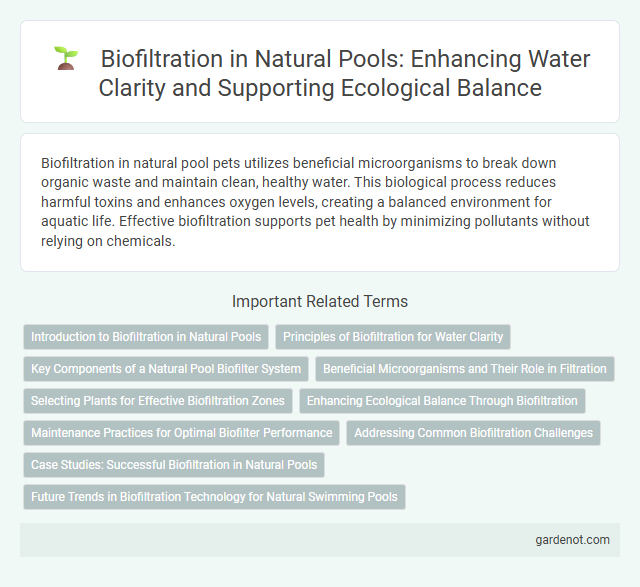Biofiltration in natural pool pets utilizes beneficial microorganisms to break down organic waste and maintain clean, healthy water. This biological process reduces harmful toxins and enhances oxygen levels, creating a balanced environment for aquatic life. Effective biofiltration supports pet health by minimizing pollutants without relying on chemicals.
Introduction to Biofiltration in Natural Pools
Biofiltration in natural pools utilizes beneficial microorganisms and plants to filter and purify water, enhancing water clarity without chemicals. This process mimics natural ecosystems, where biofilms on surfaces and root zones break down organic matter and remove contaminants. Effective biofiltration systems combine gravel, sand, and aquatic vegetation to create a balanced environment supporting sustainable water quality maintenance.
Principles of Biofiltration for Water Clarity
Biofiltration in natural pools relies on microbial communities to break down organic matter and contaminants, enhancing water clarity through biological processes rather than chemical treatments. This process involves the use of filter media such as gravel or sand, where beneficial bacteria thrive and metabolize pollutants, converting harmful substances into inert compounds. Effective biofiltration maintains a balanced ecosystem, promoting nutrient cycling and preventing algae overgrowth, which are critical for sustaining crystal-clear water in natural swimming environments.
Key Components of a Natural Pool Biofilter System
The key components of a natural pool biofilter system include a submerged biological filter media, aquatic plants, and a circulation pump to ensure efficient water flow through the filter. The submerged media, often made of porous materials like gravel or lava rock, provides a habitat for beneficial microorganisms that break down organic waste and contaminants. Aquatic plants contribute to nutrient uptake and oxygenation, creating a balanced ecosystem that maintains water clarity without chemical additives.
Beneficial Microorganisms and Their Role in Filtration
Beneficial microorganisms in biofiltration play a crucial role in maintaining water clarity by breaking down organic matter and converting harmful substances into less toxic compounds. These microbes form biofilms on filtration media, enhancing nutrient absorption and promoting the natural purification process. Their activity helps sustain a balanced ecosystem within a natural pool, reducing the need for chemical treatments and supporting healthy aquatic life.
Selecting Plants for Effective Biofiltration Zones
Selecting plants for effective biofiltration zones in natural pools involves choosing species with high nutrient uptake and strong root systems, such as cattails, water lilies, and rushes. These plants facilitate the removal of contaminants by promoting microbial activity and stabilizing sediments, ensuring optimal water clarity and ecosystem balance. Incorporating diverse native aquatic plants enhances biofiltration efficiency and supports habitat biodiversity.
Enhancing Ecological Balance Through Biofiltration
Biofiltration in natural pools utilizes aquatic plants and beneficial microorganisms to break down organic matter, effectively filtering impurities and maintaining water clarity without chemicals. This process fosters a balanced ecosystem by promoting nutrient cycling and supporting diverse microbial communities that prevent harmful algae growth. Enhancing ecological balance through biofiltration ensures sustainable water quality, creating a harmonious habitat for wildlife and swimmers alike.
Maintenance Practices for Optimal Biofilter Performance
Regular removal of accumulated debris and sediment from the biofilter maintains effective water flow and prevents clogging in natural pools. Periodic inspection of plant health and root growth ensures the biofilter's biological activity remains robust, supporting continuous nutrient absorption. Monitoring water parameters such as pH, temperature, and dissolved oxygen aids in adjusting conditions to optimize microbial processes within the biofiltration system.
Addressing Common Biofiltration Challenges
Biofiltration systems in natural pools effectively reduce contaminants by utilizing beneficial microorganisms that break down organic matter. Addressing common challenges such as clogging and uneven flow involves regular maintenance, proper plant selection, and optimizing substrate materials to enhance microbial activity. Ensuring balanced nutrient levels and adequate oxygen supply promotes efficient biofiltration, maintaining clear, healthy water while supporting a sustainable ecosystem.
Case Studies: Successful Biofiltration in Natural Pools
Case studies demonstrate that biofiltration effectively maintains water quality in natural pools by leveraging plants and beneficial microbes to break down contaminants. In notable projects, such as the Villa Savoye natural pond, biofiltration systems have consistently reduced nitrogen and phosphorus levels, promoting clear, balanced ecosystems. These examples highlight the role of biofilters in sustaining healthy aquatic environments without chemical treatments.
Future Trends in Biofiltration Technology for Natural Swimming Pools
Future trends in biofiltration technology for natural swimming pools emphasize enhanced microbial communities and advanced plant-based filtration systems to improve water clarity and ecological balance. Integration of nanomaterials and bioengineered organisms is being explored to increase pollutant degradation and nutrient cycling efficiency. Smart monitoring systems utilizing IoT sensors are expected to optimize real-time water quality management, ensuring sustainable and chemical-free pool maintenance.
Biofiltration Infographic

 gardenot.com
gardenot.com